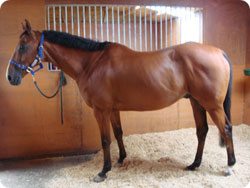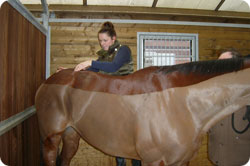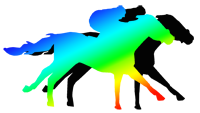Pre Visit Info and What to Expect on our First and any Subsequent Visits
 Visual examination by The Equine Therapist
Visual examination by The Equine TherapistAt the Equine Therapist, Clare aim's to provide natural, non invasive therapy to help treat your horse under relaxed conditions. This is best achieved by the horse being in its own familiar surroundings, so we will travel to you for the initial assessment and any treatment.
No initial preparation before our visit is necessary but we do ask for the animal to be clean and dry. Any rugs or bandages should be removed before the examination takes place. It is preferable for the examination and any treatment to take place inside, but if this is not possible, just let us know before we arrive.
On our first visit we will start by having an in depth conversation with you about the horse's condition, it's history if known, including any injuries, traumas or treatments that it may have had. We may also ask you about it's regular feeding, worming and exercise routine, it's breeding, age, any recent illnesses etc as this provides us with good background information about the animal.
A thorough visual examination of the horse is then carried out, looking at the animal from all angles. This allows us to identify any areas of increased muscle mass or wastage or spot indications of spine misalignment, or uneven weight distribution.
 Physical examination of the animals
Physical examination of the animals spine and muscles
Following the visual examination, we may ask you to trot your horse up so that we can assess it's movement and identify any unevenness in it's gait.
Clare will then give the horse a thorough physical examination from "top to toe" feeling all across the animal to identify any anomalies, such as muscle wastage, tension or muscle spasm. This will include moving various parts of the horse such as stretching legs and moving the head and neck. This helps to identify any stiffness or discomfort in different areas.
When the examination is finished we will discuss our findings in detail with you and recommend the best treatment to resolve the problem. If you are happy then we will start treatment. Depending on the individual problem, this may involve McTimoney-Corley spinal manipulation as well as massage, or it could be laser or magnetic therapy. If any further treatments are required then we will advise you of how many we would recommend and then arrange them at a time that is convenient.
Before our visit, we recommend that you advise your vet that you are having an equine therapist examine your horse which may involve spinal manipulation techniques and massage.
